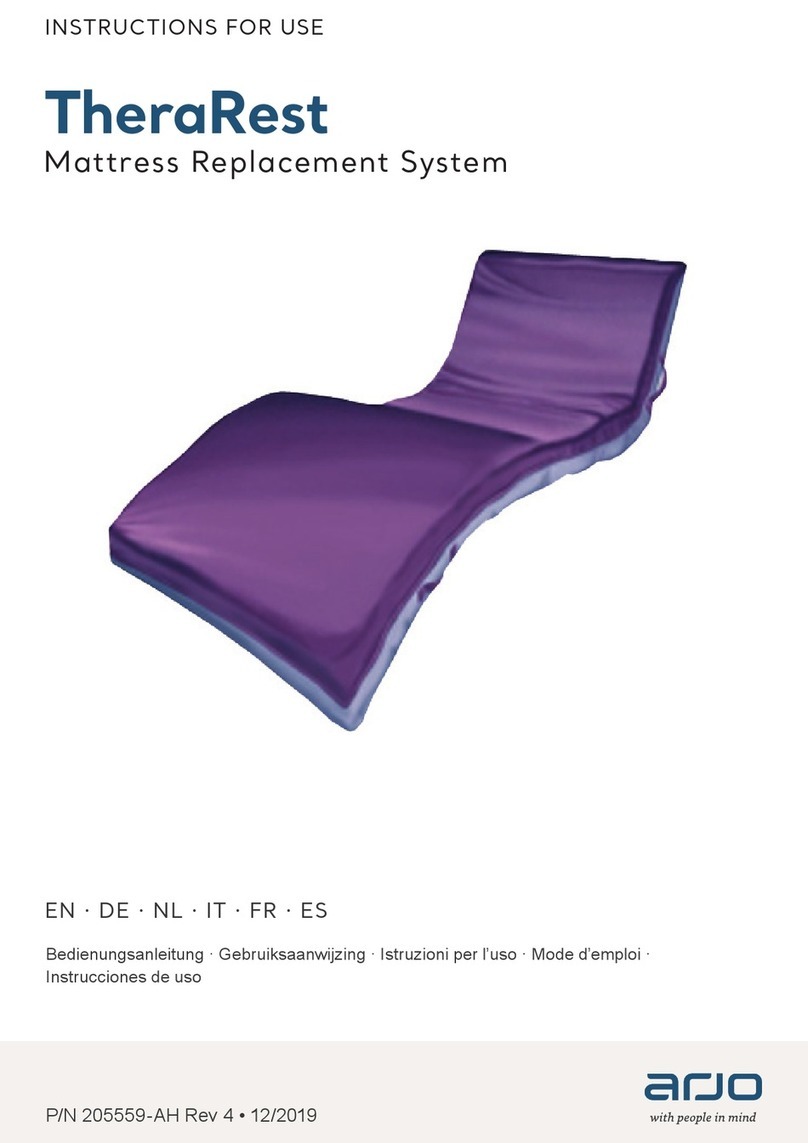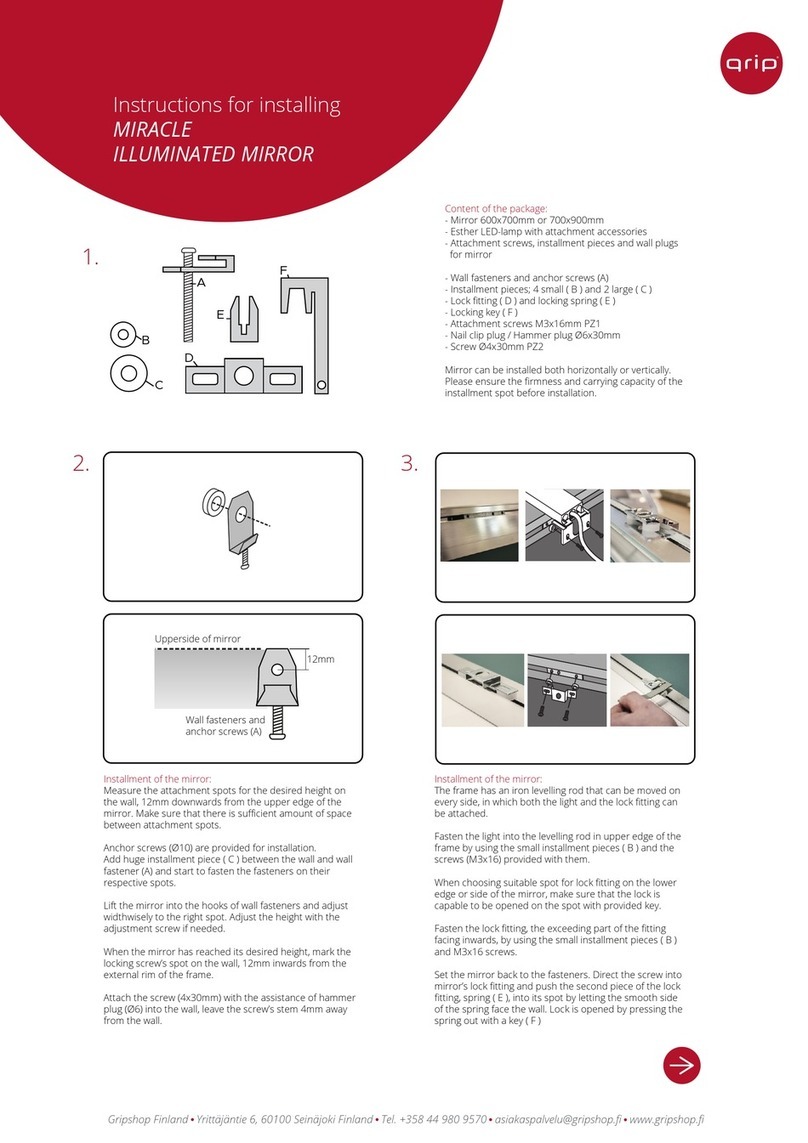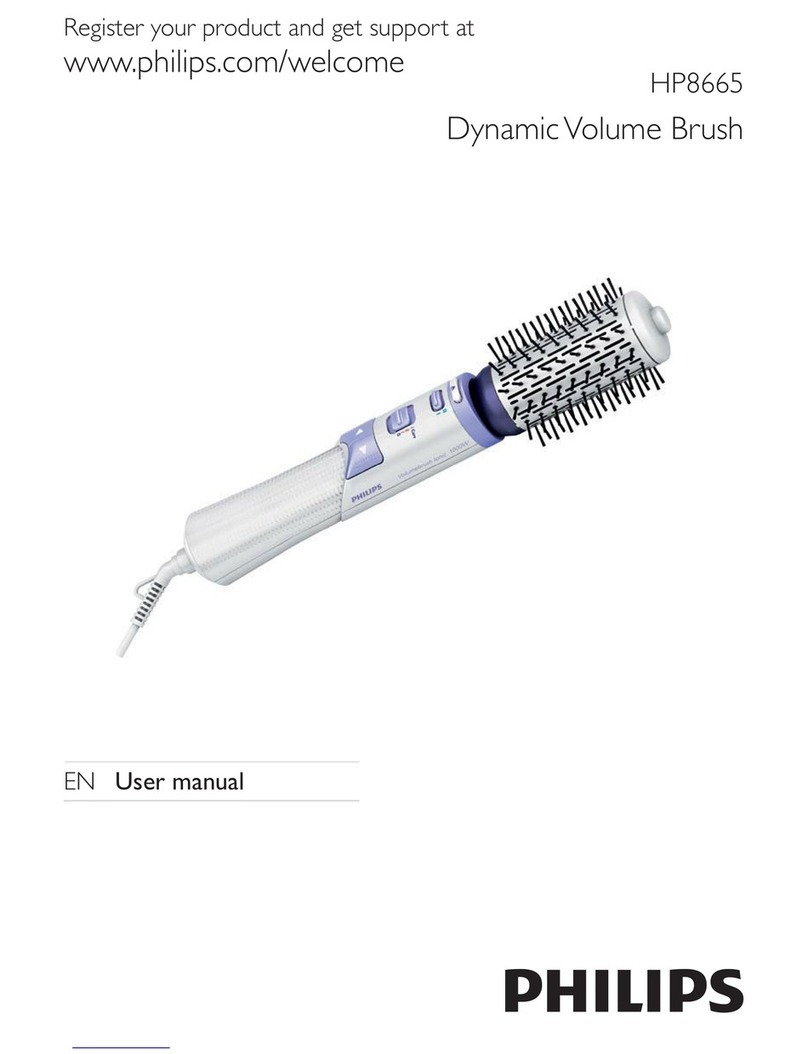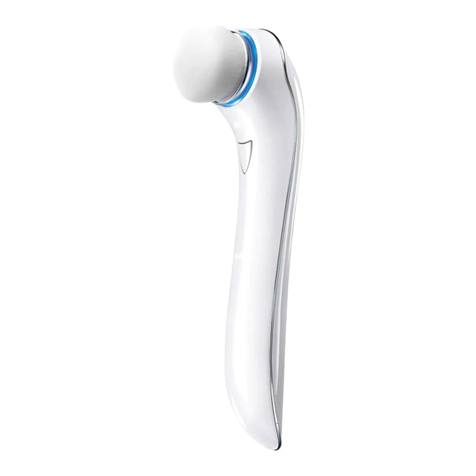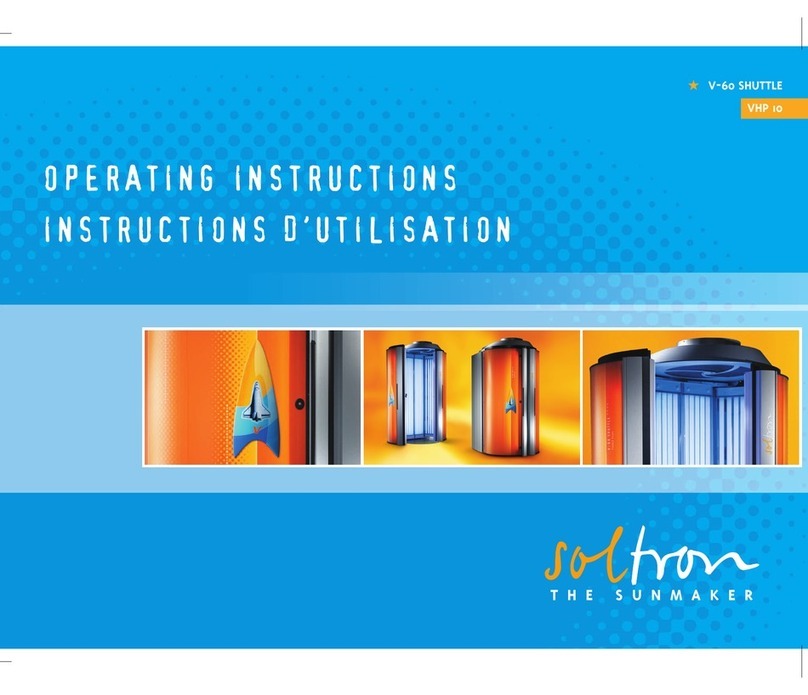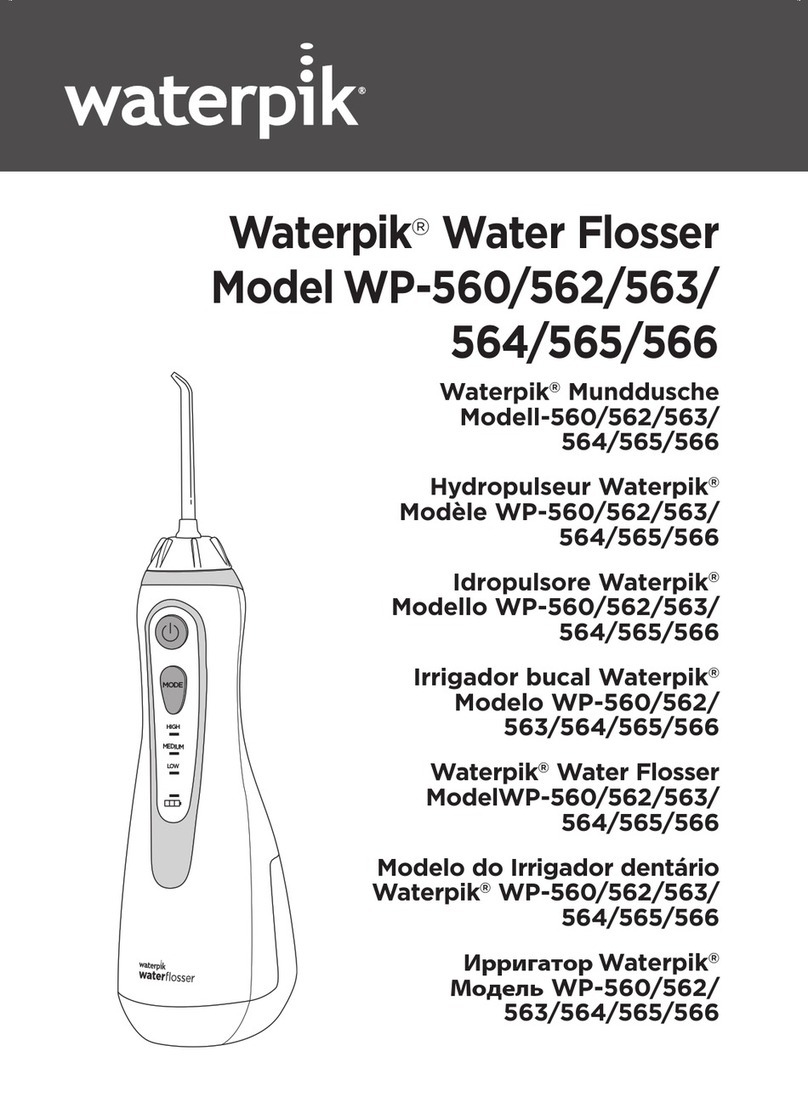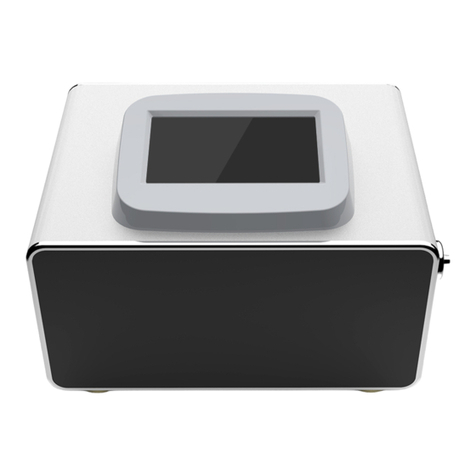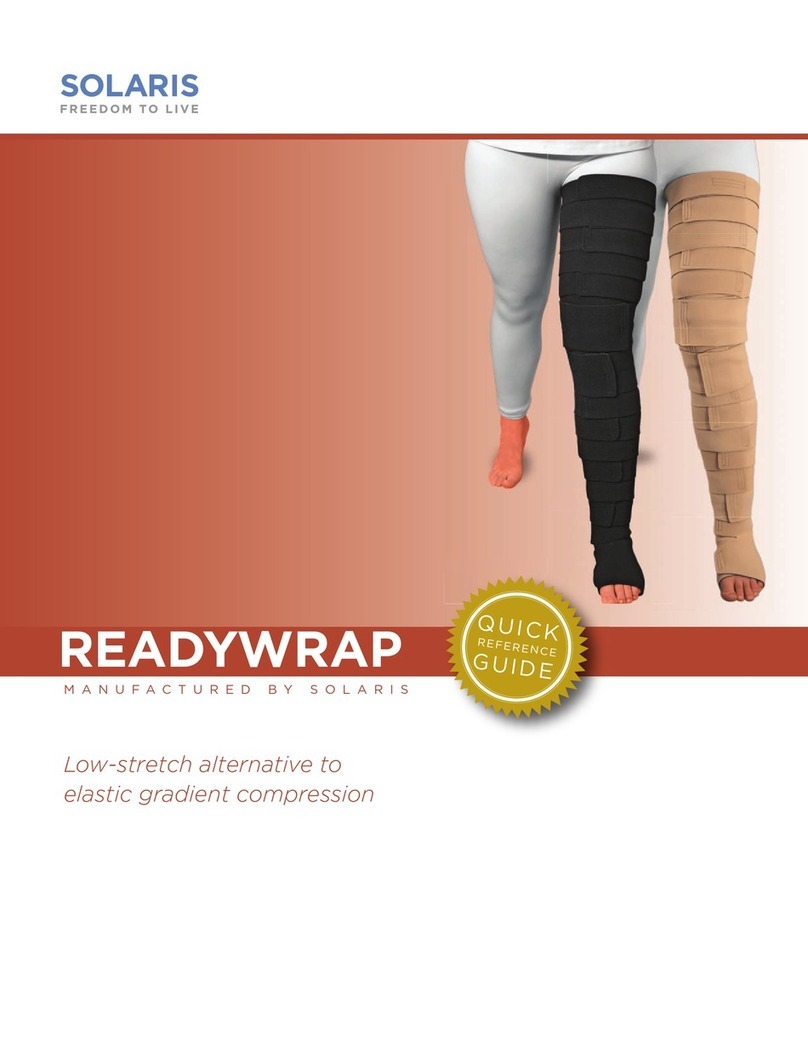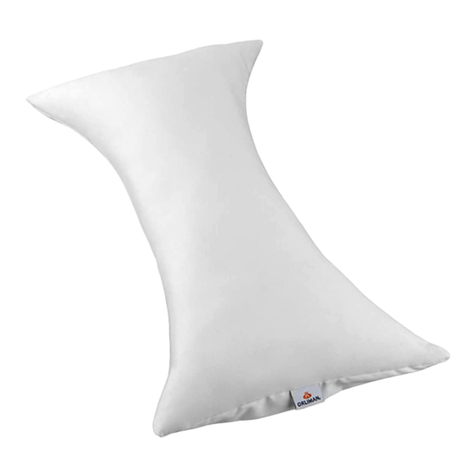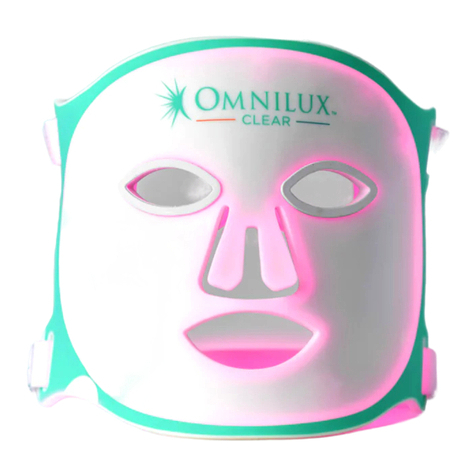Arjo MAA4031-M User manual

EN · ZH · DE · FR · IT · NL
∎䞷広㢝 ·Bedienungsanleitung · Notice d’utilisation · Istruzioni per l’uso · Gebruiksaanwijzing
INSTRUCTIONS FOR USE
Toilet Slings
04.ST.00-INT1_5 · 04/2018

2
WARNING
To avoid injury, always read this Instructions for Use and accompanied documents
before using the product. Mandatory to read the Instructions for Use.
Design Policy and Copyright
® and ™ are trademarks belonging to the ArjoHuntleigh group of companies. © ArjoHuntleigh 2014.
As our policy is one of continuous improvement, we reserve the right to modify designs without prior notice. The
content of this publication may not be copied either whole or in part without the consent of ArjoHuntleigh.
Foreword
Thank you for purchasing ArjoHuntleigh equipment. Please read this Instructions For Use (IFU)
thoroughly!
ArjoHuntleigh will not be held responsible for any accidents, incidents or lack of performance that occur as a
result of any unauthorized modification to its products.
Customer Support
If you require further information, please contact your local ArjoHuntleigh representative. The contact
information is located at the end of this IFU.
Definitions in this IFU
WARNING Means: Safety warning. Failure to understand and obey this warning may result in injury
to you or to others.
CAUTION Means: Failure to follow these instructions may cause damage to all or parts of the
system or equipment.
NOTE Means: This is important information for the correct use of this system or equipment.
Contents
Foreword .............................................................2
Customer Support...................................................2
De¿nitions in this IFU..............................................2
Intended Use.......................................................3
Patient/Patient Assessment ....................................3
Expected Service Life .............................................3
Safety Instructions...............................................3
Safety Practises......................................................3
Parts Designation................................................4
Preparations........................................................4
Before First Use (6 steps).......................................4
Before Every Use (5 steps).....................................4
Select Sling Size..................................................5
Using the ArjoHuntleigh Measuring Tape (4 steps)
(Accessory).............................................................5
Sizing Without a Measuring Tape (2 steps).............5
Sling Selection.....................................................5
Transfer/Transport...................................................5
Allowed Combinations.........................................6
Safe Working Load (SWL).......................................6
Clip Attachment & Detachment............................7
Attach the Clips (5 steps)........................................7
Detach the Clips (3 steps).......................................7
Loop Attachment & Detachment..........................7
Attach the Loops (5 Steps)......................................7
Detach the Loops (2 steps).....................................7
Applying the Sling................................................8
In Bed (24 steps).....................................................8
In Chair/ Wheelchair (24 steps)...............................9
On Floor..................................................................9
Removing the Sling ...........................................10
In Bed (14 steps)...................................................10
In Chair/Wheelchair (13 steps)..............................10
Cleaning and Disinfection..................................11
Cleaning Instruction (6 steps) ...............................11
Cleaning Chemicals.............................................. 11
Disinfection............................................................11
Care and Preventive Maintenance....................11
Before and After Every Use...................................11
When Soiled or Stained and Between Patients .... 11
Storage..................................................................11
Service and Maintenance......................................11
Troubleshooting.................................................12
Technical Speci¿cations ....................................13
Label on the Sling..............................................14
INSTRUCTIONS FOR USE
EN

3
Intended Use
Toilet Sling has been specially designed to help support
patients/residents while toileting, when used solely in
conjunction with ArjoHuntleigh patient/resident lifts
fitted with a four point tilting frame.
Do not use the Toilet Sling for lifting and
transportation apart from toilet visits.
The Toilet Sling shall only be used by appropriately
trained caregivers with adequate knowledge of the care
environment, and in accordance with the instructions
outlined in the Instructions for Use.
The Toilet Sling is intended to be used in hospital
environments, nursing homes, other healthcare
facilities and home care.
The Toilet Sling should only be used for the purpose
specified in this Instructions for Use. Any other use is
prohibited.
Patient/Resident Assessment
We recommend that facilities establish regular
assessment routines. Caregivers should assess each
patient/resident according to the following criteria
prior to use:
• Patient/resident sits in wheelchair
• Has no capacity to support herself/himself at all
• Cannot stand unsupported and is not able to bear
weight, not even partially
• Dependent on caregiver in most situations
• Physically demanding for caregiver
• Stimulation of remaining abilities is very important
• Requires some trunk stability as a must for this
type of sling
Safe Working Load (SWL) for Toilet Sling:
• MAA4031M, MLA4031, MLA4531: 272 kg
(600lbs).
The right type and size of slings should be used after
proper assessment of each patient/resident’s size,
condition and the type of lifting situation.
If the patient/resident does not meet these criteria an
alternative equipment/system shall be used.
Expected Service Life
The expected service life of Toilet Sling is the
maximum period of useful life.
The expected life of the sling is dependent on the
actual use conditions. Therefore, before use, always
make sure that the sling does not show any sign of
fraying, tearing or other damage and that there is no
damage (i.e. cracking, bending, breaking). If any such
damage is observed, do not use the sling. If you have
any doubts about sling safety, as a precaution and to
ensure safety, do not use the sling.
The expected service life of the Toilet Slings:
Service Time:
• 2 years
Shelf Time:
• 5 years
Safety Instructions
WARNING
To avoid injury, make sure that the patient is
not left unattended at any time.
WARNING
To avoid injury, only use the Toilet sling on
patients with upper body strength. Lack of
upper body strength can cause the patient
to slide out.
WARNING
To avoid falling, make sure that the user
weight is lower than the safe working load
for all products or accessories being used.
WARNING
To avoid injury, only store the equipment for
a short period of time. If stored longer than
stated in the IFU, it can cause weakness
and breakage in the material.
WARNING
To avoid injury, always assess the patient
prior to use.
WARNING
To avoid injury, never let the patient smoke
when using the sling. The sling can catch
on fire.
WARNING
To avoid injury, keep the equipment away
from sun/UV-light. Exposure to sun/UV-light
can weaken the material.
Safety Practises
• At any time, if the patient becomes agitated, stop
transferring/transporting and safely lower the
patient.
• Patient with spasm can be lifted, but great care
should be taken to support the patient’s legs.
EN

4
Parts Designation
Preparations
Before First Use (6 steps)
&KHFNDOOSDUWVRIWKHVOLQJVHHVHFWLRQ“Parts
Designation” on page 4,IDQ\SDUWLVPLVVLQJ
RUGDPDJHG'R127XVHWKHVOLQJ
Read this IFUWKRURXJKO\
&KHFNWKDWWKHVOLQJLVFOHDQ
&KRRVHDGHVLJQDWHGDUHDZKHUHWKHIFU should be
NHSWDQGHDVLO\DFFHVVLEOHDWDOOWLPHV
Make sure to have a rescue plan ready in case of a
SDWLHQWHPHUJHQF\
)RUTXHVWLRQVFRQWDFW\RXUORFDO$UMR+XQWOHLJK
UHSUHVHQWDWLYHIRUVXSSRUW
NOTE
ArjoHuntleigh recommends the name of the
patient is written on the sling care label to avoid
cross contamination between patients.
Before Every Use (5 steps)
Patient assessment must always determine the
methods used in everyday care, see “Intended
Use” on page 3
WARNING
To avoid the patient from falling, make sure
to select the correct sling size according to
the IFU.
&KHFNWKHDOORZHGFRPELQDWLRQVDJDLQVWWKHVOLQJ
spreader bar and lift, see “Allowed Combinations”
on page 6
WARNING
To avoid injury, always make sure to inspect
the equipment prior to use.
&KHFNDOOSDUWVRIWKHVOLQJVHH“Parts
Designation” on page 4,IDQ\SDUWLVPLVVLQJ
RUGDPDJHG'R127XVHWKHVOLQJ&KHFNIRU
• fraying
• loose stitching
• tears
• fabric holes
• soiled fabric
• damaged clips/loops
• damaged buckles
• unreadable or damaged label
WARNING
To prevent cross-contamination, always
follow the disinfection instructions in this
IFU.
&KHFNWKDWWKHVOLQJLVFOHDQ,IWKHVOLQJLV
not clean see”Cleaning and Disinfection” on
page 11
Before using the sling, read the lift IFUIRUWUDQVIHU
Sling label
(located outside of the sling)
Stiffener pocket
Stiffener
Neck buckle
Attachment clip (shoulder)
Pull handle
/HJÀDS
Leg strap
Attachment clip (leg)
Mid section
Midsection buckle
Head section
Support belt (hook and loop)
Attachment loop (leg)
Attachment loop (shoulder)
Example of slings. Not all models are represented.
23
9
8
10
4
7
11
12
13
13
14
1
11
EN

5
Fig. 1
Fig. 2
43 52 61 72.7 99.6 104.7 114.794.784.7
AB
COCCYX HEAD
cm
in
16,9 20.5 24 28.7 33.7 37.6 39.5 41.5 45.2
XXS XS S M L LL XL XXL
Select Sling Size
Using the ArjoHuntleigh Measuring
Tape (4 steps) (Accessory)
The ArjoHuntleigh Measuring Tape is a sizing
accessory only intended as a guide and is an
approximation. Patient width and body proportions
should also be considered when selecting the correct
size of ArjoHuntleigh sling.
1. If possible, the patient should be in a seated
position.
2. Place the point marked A on the measuring tape
over the patient’s coccyx/against seat (position A).
(See Fig. 1) and (See Fig. 2)
3. Measure from coccyx/seat (position A) to the top
of the head (position B)(See Fig. 1).
4. The coloured area on the measuring tape that is
levelled with the top of the patient’s head indicates
the required sling size. If the sling size falls in
between two sizes, it is recommended to select the
smaller size. (See Fig. 2)
Sizing Without a Measuring Tape
(2 steps)
1. Place the sling over the patient’s back.
2. Make sure the sling covers the patient from the top
of the head (position B) to the coccyx (position A).
(See Fig. 1)
Sling Selection
The patient’s physical disabilities, weight distribution and general physique needs to be taken into consideration
when selecting a sling.
Transfer/Transport
Article
number Safe Working
Load Product Description Size
MAA4031M 272 (600 lbs) Clip toilet with head support XS, S, M, L, LL, XL, XXL
MLA4031 272 (600 lbs) Loop toilet with head support S, M, L, XL,
MLA4531 272 (600 lbs) Loop toilet w/o head support S, M, L, XL,
EN

6
Allowed Combinations
WARNING
To avoid injury, always follow the allowed combinations listed in this IFU. No other
combinations are allowed.
Safe Working Load (SWL)
Always follow the lowest SWL of the total system. E.g. the Maxi Twin Compact lift/spreader bar has a SWL
of 160 kg (352 lbs) and the MAA4031 sling has a SWL of 272 kg (600 lbs). This means that the Maxi Twin
Compact lift /spreader bar has the lowest SWL. The patient is not allowed to weigh more than the lowest SWL.
Lift Maxi Twin
Compact Maxi Lite Maxi 500 Maxi Twin
SWL 160 kg
(352 lbs) 160 kg
(352 lbs) 227 kg
(500 lbs) 182 kg (401 lbs)
Spreader Bar
(DPS) Power Medium Flat Manual Manual
Medium Power
Sling SWL Size Size Size Size Size
MAA 4031M 272kg (600 lbs) S, M, L, LL, XL S, M, L S, M, L, LL S, M, L, LL S, M, L, LL, XL
Lift Maxi Move Maxi Sky
SWL 227 kg (500 lbs) 272 kg
(600 lbs)
Spreader
Bar (DPS) Manual
Small Manual
Medium Power Medium Power
Large Manual
Flat Power Medium
Sling SWL Size Size Size Size Size Size
MAA 4031M 272kg
(600 lbs) XS, S S, M, L, LL S, M, L, LL, XL L, LL, XL,
XXL S, M, L S, M, L, LL, XL
Lift Minstrel Maxi 500 Maxi Twin
SWL 190 kg
(418 lbs) 227 kg
(500 lbs) 182 kg (401 lbs)
Spreader Bar 4 point 2 point Loop 2 point Small 2 point
Medium 4 point
Large
Sling SWL Size Size Size Size Size
MLA4531M 272kg (600 lbs) M, L, XL S, M, L, XL S, M S, M, L, XL M, L, XL
MLA4031 272kg (600 lbs) M, L, XL S, M, L, XL S, M S, M, L, XL M, L, XL
Lift Maxi Move Maxi Sky
440 Maxi Sky
600
SWL 125 kg (275 lbs) 227 kg (500 lbs) 200 kg
(440 lbs) 272 kg
(600 lbs)
Spreader Bar 2 point
Small 2 point
Medium 2 point
loop 4 point
loop Fix 2 point
Medium
Sling SWL Size Size Size Size Size Size
MLA4531 272kg (600 lbs) S, M S, M, L, XL S, M, L, XL M, L, XL S, M, L, XL S, M, L, XL
MLA4031 272kg (600 lbs) S, M S, M, L, XL S, M, L, XL M, L, XL S, M, L, XL S, M, L, XL
EN

7
Clip Attachment & Detachment
NOTE
If available on your lift device, reposition the
spreader bar using the Dynamic Position
System (DPS) for easier clip attachment of the
sling. See lift IFU for instructions.
Attach the Clips (5 steps)
1. Place the clip on the spreader bar lug. (See Fig. 3)
2. Pull the strap down.
3. Make sure the lug is locked at the top end of the
clip. (See Fig. 4)
4. Make sure the strap is not squeezed in between the
clip and the spreader bar.
5. Make sure the straps are not twisted.
Detach the Clips (3 steps)
Make sure that the weight of the patient is taken up by
the receiving surface before removing the clip.
1. Pull the strap up. (See Fig. 5)
2. Make sure the lug is unlocked at the bottom of the
clip.
3. Remove the clip.
Loop Attachment & Detachment
2 point spreader bar: First attach the shoulder loops,
then attach the leg loops.
4 point spreader bar: First attach the shoulder loops
in the front hooks. Then attach the leg loops in the
back hooks
WARNING
Do not cross the shoulder straps.
Attach the Loops (5 Steps)
WARNING
Use the same loop length (loop colour) for
the shoulder straps and the same length
(loop colour) for the leg straps.
1. Place the loop over the spring loaded latch (A).
(See Fig. 6)
2. Pull the loop down to force the latch to open.
3. Make sure that the spring loaded latch closes
completely with the loop inside. (See Fig. 6)
4. Make sure that the latch is moving freely.
5. Make sure loops and straps are not twisted.
NOTE
The loops lengths on the straps are used to
adjust the patient’s position and comfort.
• Loops closer to the shoulders;
more forward position
• Loops further away from the shoulders;
more reclined position
• Loops closer to the legs;
raised legs/bottom
• Loops further away from legs;
lowered legs/bottom
Detach the Loops (2 steps)
Make sure that the weight of the patient is taken up by
the receiving surface before removing the loop.
Method 1
1. Press the spring loaded latch open.
2. Remove the loop.
Method 2
1. Pull one side of the loop over the hook and spring
loaded latch.(See Fig. 7)
2. Pull down the loop. (See Fig. 8)
Fig. 3 Fig. 4 Fig. 5
A
Fig. 6 Fig. 7 Fig. 8
EN

8
Applying the Sling
In Bed (24 steps)
For transfer see respective lift IFU.
1. Place the lift nearby.
2. Apply bed brakes and adjust the height of the bed
to an ergonomic position, if possible.
3. The patient needs to be in a seated position in bed.
4. Check that the stiffeners are completely inside the
stiffener pockets, if any.
5. Prepare the patient for transfer/toileting by
loosening the patient’s clothing.
6. Lean the patient forward.
7. Place the inside of the sling against the patients
back. The sling label is located on the outside. If
needed, use an ArjoHuntleigh Sliding Sheet/Tube
for placing the sling. See respective sliding sheet/
tube IFU.
8. Make sure that the centre line of the sling is aligned
with the patient’s spine and coccyx.
9. Lean the patient back.
10.Attach the support belt around the patient’s
midsection, if any. This prevents the patient from
falling forward.
11. Place the leg flaps underneath the patient’s legs.
12.Make sure that the: (See Fig. 9)
• sling is centred and flat without creases,
• sling’s head support covers the neck/head area,
• sling pieces are not twisted underneath the
patient and
• patient’s arms are outside the sling.
13.Apply the brakes on the lift.
WARNING
To avoid injury to the patient, pay close
attention when lowering or adjusting the
spreader bar.
14.Attach the sling, start with the midsection and then
the legs.
• If using a loop sling, attach the loops in a more
seated position.
• If using a clip sling, position the DPS
(Dynamic Positioning System) in a seated
position.
15.Slightly lift the patient to create tension in the
sling. (See Fig. 10)
WARNING
To avoid the patient from falling, make sure
that the sling attachments are attached
securely before and during the lifting
process.
16.Make sure that:
• All clips/loops are securely attached
(See Fig. 4) and (See Fig. 6)
• All straps are straight (not twisted)
• The patient lays comfortably in the sling.
17.If an adjustment is needed, lower the patient and
make sure that the weight of the patient is taken up
by the receiving surface before removing the clip/
loop.
18.Attach the neck buckle to midsection of sling, if
any.
19.Check that the patient is not sliding out through
the bottom of the sling. If the patient is sliding out,
replace it with a smaller sling.
20.Continue lifting the patient.
21.Transfer the patient to the toilet according to the
lift IFU.
22.Do NOT apply any lift brakes.
23.Push the sling/straps and not the patient towards
the back of the toilet for better positioning.
24.Lower the patient on the toilet seat. See the lift
IFU. (See Fig. 11)
Fig. 9 Fig. 10 Fig. 11
EN

9
In Chair/ Wheelchair (24 steps)
1. Place the lift nearby.
2. Apply the brakes on the wheelchair.
3. Check that the stiffeners are completely inside the
stiffener pockets, if any.
4. Prepare the patient for transfer by loosening the
patient’s clothing.
5. Stand in front of the patient and lean the patient
forward.
6. Place the inside of the sling against the patients
back. The sling label is located on the outside. If
needed, use an ArjoHuntleigh sliding sheet/tube
for placing the sling See respective Sliding sheet/
tube IFU.
7. Make sure that the centre line is aligned with the
patient’s spine and coccyx.
8. Lean the patient back.
9. Attach the support belt around the patient’s
midsection, if any. This prevents the patient from
falling forward.
10.Place the leg flaps underneath the legs.
11. Make sure that the:
• sling is centred and flat without creases,
• sling’s head support covers the neck/head area,
• sling pieces are not twisted underneath the
patient and
• patient’s arms are outside the sling.
12.Place the lift in front of the patient and open the lift
chassis legs, if needed. (See Fig. 12)
13.Apply the brakes on the lift.
WARNING
To avoid injury to the patient, pay close
attention when lowering or adjusting the
spreader bar.
14.Attach the sling, start with the midsection and then
the legs.
• If using a loop sling, attach the loops in a more
seated position.
• If using a clip sling, position the DPS
(Dynamic Positioning System) in a seated
position.
WARNING
Make sure straps are not caught by
wheelchair or lift castors.
15.Slightly lift the patient to create tension in the
sling. (See Fig. 12)
WARNING
To avoid the patient from falling, make sure
that the sling attachments are attached
securely before and during the lifting
process.
16.Make sure that:
• All clips/loops are securely attached
(See Fig. 4) and (See Fig. 6)
• All straps are straight (not twisted)
• The patient lays comfortably in the sling.
17.If an adjustment is needed, lower the patient and
make sure that the weight of the patient is taken up
by the receiving surface before removing the clip/
loop.
18.Attach the neck buckle to midsection of sling, if
any.
WARNING
To avoid injury, always make sure the sling
is attached correctly.
19.Check that the patient is not sliding out through
the bottom of the sling. If the patient is sliding out,
replace it with a smaller sling.
20.Continue to lift the patient.
21.Transfer the patient to the toilet according to the
lift IFU.
22.Do NOT apply any lift brakes.
23.Slightly push the sling/straps and not the patient,
towards the back of the toilet for better positioning.
24.Lower the patient on the toilet seat. See the lift
IFU.(See Fig. 13)
On Floor
Do NOT use Toilet sling. Use an appropriate sling to
lift from the floor.
Fig. 12 Fig. 13
EN

10
Removing the Sling
In Bed (14 steps)
1. Position the patient over the bed. (See Fig. 14)
2. Apply bed brakes and adjust the height of the bed
to an ergonomic position, if possible.
3. Adjust the bed to a seated position
4. If using a clip sling, position the DPS (Dynamic
Positioning System) in a seated position.
WARNING
To avoid injury to the patient, pay close
attention when lowering or adjusting the
spreader bar.
5. Lower the patient onto the bed. Make sure that the
weight of the patient is taken up by the receiving
surface before removing the clip/loop.
6. Detach the sling.
7. Unbuckle the head section from the midsection of
the sling.
8. Move the lift away from the patient.
9. Detach the sling belt around the patient’s
midsection, if any.
10.Pull out the leg flaps from under the patient’s legs.
11. Lean the patient forward.
12.Remove the sling. Use an ArjoHuntleigh sliding
sheet/tube for removing the sling. See respective
Sliding sheet/tube IFU.
13.Lean the patient back.
14.Make sure the patient is in a comfortable and
secure position in the bed.
In Chair/Wheelchair (13 steps)
1. Apply the brakes on the wheelchair.
2. If using a floor lift, open the lift chassis legs.
3. Position the patient over the chair/wheelchair.
4. If using a clip toilet sling, position the DPS
(Dynamic Positioning System) in a seated position.
5. Slightly push the sling/straps and not the patient,
towards the back of the chair/wheelchair for better
positioning.
WARNING
To avoid injury to the patient, pay close
attention when lowering or adjusting the
spreader bar.
6. Lower the patient into the chair/wheelchair.
7. Make sure the patients lower back is positioned all
the way in against the chair/wheelchair to avoid the
patient from sliding out.
8. Detach the sling.
9. Move the lift away from the patient. (See Fig. 15)
10.Pull out the leg flaps from under the patient’s legs
and place them backwards along the patient’s side.
11. Stand in front of the patient and lean the patient
forward.
12.Pull out the sling. If needed, use an ArjoHuntleigh
sliding sheet/tube. See respective Sliding sheet/
tube IFU.
13.Lean the patient back up to a comfortable and
secure position.
Fig. 14 Fig. 15
EN

11
Cleaning and Disinfection
WARNING
To prevent cross-contamination, always
follow the disinfection instructions in this
IFU.
WARNING
To avoid material damage and injury, clean
and disinfect according to this IFU.
• No other chemicals are allowed.
• Never clean with chlorine.
• Chlorine will deteriorate the surface of
the material.
WARNING
To avoid injury, always remove the sling
before disinfecting the lift.
All Toilet slings should be cleaned when they are
VRLOHGRUVWDLQHGDQGEHWZHHQSDWLHQWV
Cleaning Instruction (7 steps)
'HWDFKWKHVOLQJIURPWKHOLIW
5HPRYHWKHVWLIIHQHUVLIDQ\EHIRUHZDVKLQJ
&ORVHDOOEXFNOHVDQGKRRNDQGORRSDWWDFKPHQWRQ
WKHVOLQJVDQGEHOWVSULRUWRZDVKLQJ
&KHFNWKHV\PEROVRQWKHSURGXFWODEHOIRU
FOHDQLQJUHFRPPHQGDWLRQV
0DFKLQHZDVKWKHVOLQJDW&),QRUGHU
WRREWDLQVXI¿FLHQWOHYHORIGLVLQIHFWLRQSOHDVH
ZDVKDFFRUGLQJWRORFDOK\JLHQHOHJLVODWLRQ
If allowed according to the product label, tumble
GU\LQORZWHPSHUDWXUHPD[&)
'R127
• wash together with other items that have rough
VXUIDFHVRUVKDUSREMHFWV
• use any mechanical pressure, pressing or rolling
• use bleach
• use gas sterilization
• use autoclave
• dry clean
• steam
• ironing
Place the stiffeners, if any, back in to the sling
EHIRUHXVH
Cleaning Chemicals
)RUDOOVOLQJPDWHULDOXVHFRPPRQFRPPHUFLDO
GHWHUJHQWZLWKRXWRSWLFDOEULJKWHQHU1RRWKHU
FKHPLFDOVDUHDOORZHGHJFKORULQHVRIWHQHULRGLQH
EDVHGGLVLQIHFWDQWVEURPLQHDQGR]RQH
Disinfection
7KHRQO\DOORZHGGLVLQIHFWLRQLVGLVLQIHFWLRQE\
ZDVKLQJ
Care and Preventive Maintenance
WARNING
To avoid injury to both patient and
caregiver, never modify the equipment or
use incompatible parts.
Before and After Every Use
Visually check all exposed parts
7KHFDUHJLYHUVKDOOLQVSHFWWKHVOLQJEHIRUHDQGDIWHU
HYHU\XVH7KHFRPSOHWHVOLQJVKRXOGEHFKHFNHGIRU
DOOGHYLDWLRQVOLVWHGEHORZ,IDQ\RIWKHVHGHYLDWLRQV
DUHYLVLEOHUHSODFHWKHVOLQJLPPHGLDWHO\
• )UD\LQJ
• Loose stitching
• 7HDUV
• Holes
• Discolouration or stains from bleaching
• Sling soiled or stained
• Label unreadable or damaged
When Soiled or Stained and Between
Patients
Clean/Disinfect
7KHFDUHJLYHUVKRXOGPDNHVXUHWKDWWKHVOLQJLV
cleaned according to “Cleaning and Disinfection” on
page 11, when it is soiled or stained and between
SDWLHQWV,IWKHVRLODQGVWDLQVDUHVWLOOYLVLEOHUHSODFH
WKHVOLQJLPPHGLDWHO\
Storage
When not in use, the slings should be stored away
from direct sunlight where they are not subject to
XQQHFHVVDU\VWUDLQVWUHVVRUSUHVVXUHRUWRH[FHVVLYH
KHDWRUKXPLGLW\7KHVOLQJVVKRXOGEHNHSWDZD\IURP
sharp edges, corrosives or other things that could cause
GDPDJHRQWKHVOLQJ
Service and Maintenance
It is recommended that TXDOL¿HG personnel inspect the
condition of the sling twice a year (every 6 month),
DFFRUGLQJWR,62
EN

12
Troubleshooting
Problem Action
The patient is not positioned correctly in
the sling (e.g. one strap is shorter than the
other).
• Make sure the clip/loop straps are not twisted.
• Make sure the patient is seated on the inside of the
sling. The outside has a label for reference.
• Make sure the patient is centred in the sling.
The patient feels discomfort in the leg area
when seated in the sling. Make sure that there are no creases on the leg Àaps of
the sling.
The sling is dif¿cult to apply (e.g. during
log roll).
Do NOT use the log roll method. Use anArjoHuntleigh
sliding sheet/tube according to instructions in respective
IFU.
There are dif¿culties applying the shoulder
clips/loops.
• Place the patient in a more seated position in the bed
or on the Àoor. Place a pillow behind the patient’s
neck/back, outside of the sling.
• Raise the back rest of the bed, if available.
• If applicable, make sure the clip strap is not caught
between the lug on the lift and the clip attachment.
• Adjust the spreader bar to a more reclined position.
Pay attention to the patient’s head.
There are dif¿culties applying the leg clips/
loops.
• Bend the patient’s legs or place a pillow under the
patient’s knees.
• If applicable, make sure the clip strap is not caught
between the lug on the lift and the clip attachment.
• Adjust the spreader bar to a more seated position.
It is dif¿cult to use the sling in combination
with the lift and spreader bar.
Use the sling only in accordance with the combinations
described in section “Allowed Combinations” on
page 6.
The position of the patient in the sling
should be more reclined or seated. Use the spreader bar or the loop lengths to adjust the
patient’s position.
The patient wishes to have extra support
for the neck. Place a pillow behind the patient’s neck, inside the sling.
The patient is sliding out of the opening of
the sling.
• Make sure the patient’s arms are outside of the sling.
• If the problem still occurs: Select/choose a smaller
size sling.
EN

13
Technical Specifications
General
Safe working load (SWL) = Maximum total load See “Allowed Combinations” on page 6
Service life – Recommended period of use 2 years*
* Refer to “Expected Service Life” on page 3.
Shelf life – Maximum period of storing new
unpacked product 5 years
Model and Type See “Sling Selection” on page 5
Operating, Transport and Storage Environment
Temperature 0°C to +40°C (+32°F to +104°F) Operating and Storage
-25°C to +60°C (-13°F to +140°F) Transport
Humidity Max 15–70% at +20°C (68°F) Operating and Storage
Max 10–95% at +20°C (68°F) Transport
Recycling (The device should be recycled according to national regulations.)
Package The bag consists of soft plastic, recyclable to local
legislations.
Sling The sling consists of both plastics and textiles and is not
recyclable as an entity. If the parts are separated they
might be recyclable according to local legislation.
Parts and Accessories
Stiffeners GX21270, TBS106 and TBS107
Belt size: S, M & L TSB.100-V
Belt size: XL TSB.200-V
Measuring tape MTA1000
EN

14
Label on the Sling
Care and Washing Symbols
Machine wash 70°C (158°F)
No bleaching allowed
No tumble drying allowed
Tumble drying
No Ironing allowed
No dry cleaning allowed
Certificates/Markings
CE marking in accordance with the
Medical Devices Directive 93/42/EEC.
The equipment has been tested and
ful¿ls all essential requirements.
Symbol for Clip and Loop
Use a clip spreader bar.
Use a loop spreader bar.
Article Number
REF
XXXXXX-X Article number with -X refers to
the sling size.
REF
XXXXXXX
If the article number is stated
without the size letter at the end,
it means the sling is a One Size.
Fibre Content
PES Polyester
PE Polyethylene
PU Polyurethane
Misc. Symbols
Safe Working Load (SWL)
Patient’s name symbol
Record symbol
Read the IFU before use
REF Article number
Manufacturing date and year
Manufacturer name and address
EN

15
警告
为避免受到伤害,在使用产品前,必须阅读本使用说明书以及产品随附的文档。必须阅读
使用说明书。
设计原则和版权
® 和™ 是属于 ArjoHuntleigh 集团公司的商标。© ArjoHuntleigh 2014。
我们的宗旨是保持持续改进,因此我们保留更改设计的权利,恕不另行通知。未经 ArjoHuntleigh 同意,不得全部或部分
复制本出版物中的内容。
前言
ݥဠ௷ޭଳ ArjoHuntleigh රһăംښӁ෪ᅂไบ (IFU)!
ArjoHuntleigh 对任何因未经授权改动产品而导致的意外、事故或性能丧失均不承担任何责任。
客户支持
如果需要更多信息,请联系您当地的 ArjoHuntleigh 代表。联系信息位于本 IFU 的结尾。
本IFU 中的定义
警告 表示:安全性警告。如不理解并且不遵守该警告可能会对您或他人造成人身伤害。
小心 表示:如不遵守这些说明可能导致整个系统或设备或其中部分部件的损坏。
说明 表示:这些是正确使用本系统或设备的重要信息。
૽
ࡽ䀰
ᇒᡧ᭟ᤱ
ᵜ,)8ѝⲴᇊѹ
ᰒᇊ⭘䙄
ᛓ㘵⯵Ӫ䇴ՠ
亴䇑֯⭘ሯભ
ᆹޘ䈤᰾
ᆹޘ㿴㤳
䜘Ԧ〠
֯⭘߶༷
ࡍ⅑֯⭘ࡽ˄њ↕僔˅
⇿⅑֯⭘ࡽ˄њ↕僔˅
䘹ᤙތ㿴Ṭ
֯⭘$UMR+XQWOHLJK⍻ቪ˄њ↕僔˅˄䱴Ԧ˅
н֯⭘⍻ቪ⍻䟿˄њ↕僔˅
ތ䘹ᤙ
䖜䘀䘀䗃
ݱ䇨㓴
ᆹޘ䟽6:/
䘎᧕о䲔ᢓ
䘎᧕ᢓ˄њ↕僔˅
䲔ᢓ˄њ↕僔˅
䘎᧕о䲔⧟
䘎᧕⧟˄њ↕僔˅
䲔⧟˄њ↕僔˅
ᓄ⭘ތ
൘ᒺк˄њ↕僔˅
൘ᓗἵ䖞ἵк˄њ↕僔˅
൘ൠᶯк
䲔ތ
൘ᒺк˄њ↕僔˅
൘ᓗἵ䖞ἵк˄њ↕僔˅
⌱઼⎸∂
⌱䈤᰾˄њ↕僔˅
⌱⭘ᆖ૱
⎸∂
؍ޫ઼䱢ᣔᙗ㔤ᣔ
⇿⅑֯⭘ࡽ
㜿ḃ⊑ᡆ⭘ҾަԆᛓ㘵ᰦ
䍞ᆈ
؍ޫ઼㔤ᣔ
᭵䳌ᧂ䲔
ᢰᵟ㿴Ṭ
ތкⲴḷ⡼
使用说明书
ZH

16
既定用途
如厕用吊兜
经过专门设计,当只与配有四点式倾斜
框架的 ArjoHuntleigh 患者移位机配套使用时,可
帮助患者如厕。
除了用于如厕
之外,
请勿
将如厕用吊兜用于
移位和
运输用途。
如厕用吊兜仅供对护理环境有充分了解,并遵守使
用说明书中的说明概述使用。
如厕用吊兜
适合在医院环境、护理中心、其他健康
护理机构和家庭中使用。
如厕用吊兜
只能用于此使用说明书中指定的用途。
禁止用于其他目的。
患者/病人评估
我们建议使用机构建立日常评估程序。护理人员应
在使用本设备前根据以下标准评估每名患者/病人:
•患者/病人坐轮椅
•完全没有能力支撑自己的身体
•不能自行站立,也无法承受自己的体重(甚至
部分体重);
•在大部分情况下依赖护理人员
•需要护理人员提供身体支撑
•刺激剩余能力非常重要
•对于此类吊兜,务必确保躯干稳定
厕用吊兜的
安全承重 (SWL):
• MAA4031M,MLA4031,MLA4531:272 kg
(600lbs)。
正确评估每个患者/病人的体格、条件和吊升环境
后,应使用适合的吊兜类型和规格。
如果患者/病人不满足这些条件,应使用其他的设
备/系统产品。
预计使用寿命
如厕用吊兜
的预期使用寿命为最长使用寿命期限。
吊兜的预期使用寿命取决于实际使用条件。因此在
使用之前,务必确保吊兜未出现磨损、撕裂或其他
损坏迹象,并且未发生损坏(即:裂口、弯曲、断
裂)。如果看到任何此类损坏情况,请勿使用吊
兜。如果对于吊兜安全有任何疑问,作为预防措施
并为了确保安全,请勿使用吊兜。
厕用吊兜
的预期使用寿命:
使用期:
• 2 年
保质期:
• 5 年
安全说明
警告
为避免人身伤害,应始终有专人看护患者。
警告
为避免受伤,只能对具有上肢力量的患者使用如
厕用吊兜。缺乏上肢力量有可能导致患者滑出。
警告
为避免摔倒,患者体重不得超出所用产品及附件
的安全工作负荷。
警告
为避免人身伤害,仅应短期存储设备。如果存储
时间超过 IFU 中规定的时间,则会导致材料断裂
和强度变弱。
警告
为避免人身伤害,应在使用前始终对患者状况
进行评估。
警告
为避免人身伤害,切勿在使用吊兜时让患者吸烟。
吊兜会导致火灾。
警告
为避免人身伤害,请避免阳光/紫外光照射到设备。
暴露于阳光/紫外光会降低材料强度。
安全规范
•当患者变得烦躁不安时,随时停止转运/运送并
安全地放低患者。
•痉挛患者可以吊升,但应特别注意支托患者的
双腿。
ZH

17
部件名称
使用准备
初次使用前(6个步骤)
1. 检查吊兜的所有部件,请参阅
第17 页上的“部件
名称”
一节。如果任何部件缺失或损坏 — 不得使
用吊兜。
2. 仔细阅读本 IFU。
3. 检查吊兜是否干净。
4. 在指定位置妥善存放 IFU,以便随时取阅。
5. 确保制定好抢救计划以防患者出现紧急情况。
6. 有关任何问题,请联系您当地的 ArjoHuntleigh
代表以寻求支持。
注意
ArjoHuntleigh 建议将患者姓名标注在吊兜保养
标牌上,避免患者之间交叉感染。
每次使用前(5个步骤)
1. 患者评估时必须始终确定日常护理中使用的方法,
请参阅
第16 页上的“既定用途”
。
警告
为避免患者坠落,请务必根据
IFU
选择正确的
吊兜尺寸。
2. 检查吊兜、吊架和移位机的允许组合,请参阅
第19 页上的“允许组合”
一节。
警告
为避免人身伤害,请始终确保在使用前检查设备。
3. 检查吊兜的所有部件,请参阅
第17 页上的“
部件名称”
一节。如果任何部件缺失或损坏 —
不得使用吊兜。检查:
•磨损
•松散缝合
•裂口
•破洞
•布料染污
•受损卡口/环
•带扣损坏
•标牌无法辨认或损坏
警告
为了防止交叉感染,必须始终遵守本 IFU 中的
消毒说明。
4. 检查吊兜是否干净。如果吊兜不干净,请参阅
第24 页上的“清洁和消毒”
。
5. 在使用吊兜之前,请阅读移位机 IFU 了解转运
说明。
1. 吊兜标牌
(位于吊兜外部)
2. 加强板袋
3. 加强板
4. 颈部卡扣
5. 卡扣(肩部)
6. 拉手
7. 腿皮瓣
8. 腿带
9. 卡扣(腿部)
10.中部
11. 中部卡扣
12.头部
13.支撑带(搭扣)
14.连接环(腿部)
15.连接环(肩部)
吊兜示例。未示出所有型号。
23
5
6
9
8
10
4
7
11
12
13
13
14
15
1
11
ZH

18
图1
图2
43 52 61 72.7 99.6 104.7 114.794.784.7
AB
COCCYX HEAD
cm
in
16,9 20.5 24 28.7 33.7 37.6 39.5 41.5 45.2
XXS XS S M L LL XL XXL
选择吊兜规格
使用 ArjoHuntleigh 测尺(4个步骤)
(附件)
ArjoHuntleigh 测尺是一种仅供参考的测量附件,
提供估算值。选择正确规格的 ArjoHuntleigh 吊兜
时,还应考虑患者体宽和身材比例。
1. 如果可能,应让患者处于坐姿。
2. 将测尺上标记 A的测点置于患者的尾骨处/顶靠
座位(位置 A)。DŽംԯᆡ༇ 1Dž和DŽംԯᆡ༇ 2Dž
3. 测量从尾骨/座位(位置 A)到头顶(位置 B)
之间的长度DŽംԯᆡ༇ 1Dž。
4. 测尺上与患者头顶平齐的彩色区域指示出所需
的吊兜规格。如果指示的吊兜规格介于两个规
格之间,则建议选择较小规格。DŽംԯᆡ༇ 2Dž
不使用测尺测量(2个步骤)
1. 将吊兜置于患者背部。
2. 确保吊兜覆盖患者头顶(位置 B)至尾骨(位
置A)之间部位。DŽംԯᆡ༇ 1Dž
吊兜选择
选择吊兜时,需要考虑病患者的肢体残疾、体重分布和总体格。
转运/运输
商品编号 安全承重 产品说明 规格
MAA4031M 272 (600 lbs) 带头托的卡扣式如厕用吊兜 XS、S、M、L、LL、XL、XXL
MLA4031 272 (600 lbs) 带头托的环状如厕用吊兜 S、M、L、XL
MLA4531 272 (600 lbs) 不带头托的环状如厕用吊兜 S、M、L、XL
测尺测量长度
ZH

19
允许组合
警告
为避免人身伤害,请始终遵循本 IFU 中所列的允许组合。不允许进行其他组合。
安全承重 (SWL)
始终遵守总体系统的最低 SWL。例如:Maxi Twin Compact 移位机/吊架的 SWL 为160 kg (352 lbs),
MAA4031 吊兜的 SWL 为272 kg (600 lbs)。这意味着 Maxi Twin Compact 移位机/吊架具有最小 SWL。患
者体重不得超过最低 SWL。
移位机 Maxi Twin
Compact Maxi Lite Maxi 500 Maxi Twin
SWL 160 kg
(352 lbs) 160 kg
(352 lbs) 227 kg
(500 lbs) 182 kg (401 lbs)
吊架 (DPS) 电动(中号) 平直 手动 手动
(中号) 电源
吊兜 SWL 规格 规格 规格 规格 规格
MAA 4031M 272kg
(600 lbs) S、M、L、LL、XL S、M、LS、M、L、LL S、M、L、LL S、M、L、LL、XL
移位机 Maxi Move Maxi Sky
SWL 227 kg (500 lbs) 272 kg
(600 lbs)
吊架
(DPS) 手动式
(小号)
手动
(中号) 电动(中号) 电动
(大号)
手动
平直
电动
(中号)
吊兜 SWL 规格 规格 规格 规格 规格 规格
MAA 4031M 272kg
(600 lbs) XS、SS、M、L、LL S、M、L、LL、XL L、LL、XL、
XXL S、M、LS、M、L、LL、XL
移位机 Minstrel Maxi 500 Maxi Twin
SWL 190 kg
(418 lbs) 227 kg
(500 lbs) 182 kg (401 lbs)
吊架 4 点式 两点式环状 两点式小号 两点式中号 四点式大号
吊兜 SWL 规格 规格 规格 规格 规格
MLA4531M 272kg (600 lbs) M、L、XL S、M、L、XL S、MS、M、L、XL M、L、XL
MLA4031 272kg (600 lbs) M、L、XL S、M、L、XL S、MS、M、L、XL M、L、XL
移位机 Maxi Move Maxi
Sky 440 Maxi
Sky 600
SWL 125 kg (275 lbs) 227 kg (500 lbs) 200 kg
(440 lbs) 272 kg
(600 lbs)
吊架 两点式
小号
两点式
(中号)
两点式
环状
四点式
环状 固定式 两点式
(中号)
吊兜 SWL 规格 规格 规格 规格 规格 规格
MLA4531 272kg (600 lbs) S、MS、M、L、XL S、M、L、XL M、L、XL S、M、L、XL S、M、L、XL
MLA4031 272kg (600 lbs) S、MS、M、L、XL S、M、L、XL M、L、XL S、M、L、XL S、M、L、XL
ZH

20
A
图6 图7 图8
连接与拆除卡扣
注意
使用动态体位调节系统 (DPS)v重新安装吊架,
以便于连接吊兜卡扣(如果您的移位机设备上提
供)。请参阅移位机 IFU 以了解说明。
连接卡扣(5个步骤)
1. 将卡扣放置在吊架卡钉上。DŽംԯᆡ༇ 3Dž
2. 下拉吊带。
3. 确保卡钉在卡扣顶端锁定。DŽംԯᆡ༇ 4Dž
4. 确保将吊带夹挤在卡扣与吊架之间。
5. 确保吊带未扭结。
拆除卡扣(3个步骤)
拆除卡扣前,确保接收面能够承受患者体重。
1. 上拉吊带。DŽംԯᆡ༇ 5Dž
2. 确保卡钉在卡扣底部松开。
3. 拆下卡扣。
连接与拆除环
2点式吊架:先连接肩环,然后连接腿环。
4点式吊架:首先将肩部环连接至前部挂钩。然后
将腿部环连接至背部挂钩。
警告
请勿交叉肩带。
连接环(5个步骤)
警告
对肩带使用相同长度环(环颜色),对腿带使用
相同长度(环颜色)。
1. 将连接环放在弹簧锁 (A)上方。DŽംԯᆡ༇ 6Dž
2. 下拉连接环迫使锁打开。
3. 确保弹簧锁完全闭合且连接环位于其中。
DŽംԯᆡ༇ 6Dž
4. 确保该锁可灵活移动。
5. 确保环与吊带未扭曲。
说明
吊带上环的长度用于调整患者的位置和舒适度。
•环靠近肩部;
位置靠前
•连接环远离肩膀;
体位更向后靠
•连接环靠近腿部;
提升腿部/下身
•连接环远离腿部;
降低腿部/下身
拆除环(2个步骤)
拆取环之前,确保接收面可承受患者体重。
方法 1
1. 按下弹簧锁以打开。
2. 取出环。
方法 2
1. 将连接环的一侧放在挂钩和弹簧锁上方。
DŽംԯᆡ༇ 7Dž
2. 下拉环。DŽംԯᆡ༇ 8Dž
图3 图4 图5
ZH
Other manuals for MAA4031-M
1
This manual suits for next models
2
Table of contents
Languages:
Other Arjo Personal Care Product manuals

